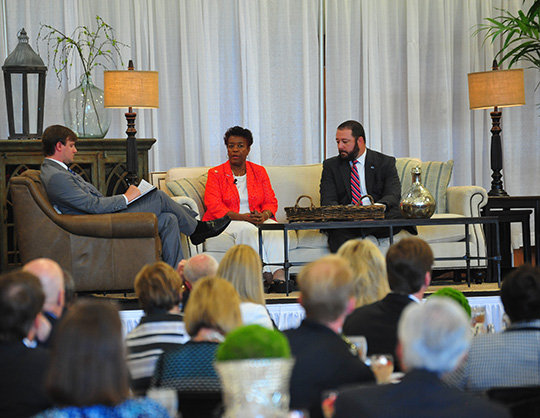

The Albany Area Chamber of Commerce held its annual State of the Community luncheon Thursday at Darton State College.
Albany Mayor Dorothy Hubbard, Dougherty Commission Chair Chris Cohilas, Darton Interim President Richard Carvajal, Albany State University President Art Dunning, Albany Technical College President Anthony Parker, Dougherty School Superintendent Butch Mosely and Commodore Conyers College and Career Academy CEO Chris Hatcher headlined the well-attended event.
The luncheon revolved around three topics: Government, work force development and education.
Hubbard and Cohilas led off the speakers.
The mayor was asked the benefits of approving the upcoming SPLOST referendum, which will be on November’s general election ballot.
“Our designated plans for SPLOST are making much-needed improvement to our city’s infrastructure,” Hubbard said. The mayor noted that a lack of hotel space had stymied efforts to bring more convention traffic into the city. But she added there are plans to possibly redevelop the Albany Civic Center into a 180-bed hotel and conference center.
Hubbard said work is also under way to create more development downtown and on the Flint Riverfront.
“I have to admit there are not many ‘sexy’ items involving our SPLOST,” Cohilas said, noting the county will spend its funds on storm drains and sewer infrastructure projects. However, he added, he’d like to see the county make a solid push on a trails project which would link Albany to Sasser.
The panel of educational leaders then mounted the stage, and Parker went immediately into a discussion of the Move on When Ready program.
“Move on When Ready is the most far-reaching piece of educational reform that I’ve seen in my 33 years in higher education,” the Albany Tech president said. “It gives high school students an opportunity to attend college while they are still in high school, along with the possibility of graduating high school with an associate’s degree.
“Certainly there will be a benefit to the parents, because their children could receive the first two years of their education while still living at home. So we are poised to be a leader in economic and work force development.”
Dunning was asked for an update in the process of the ongoing consolidation of Albany State and Darton.
“I feel, at this point, we have gotten phenomenal support from the students at Darton and the students at Albany State . As with any consolidation, you will have successes and you will have challenges. We have people in positions to meet those challenges and fix the problems. So I feel very good about where we are right now.”
Hatcher was asked about the structure of the CCCCA and how it is supposed to function.
“The definition of a college and career academy is a specialized charter school established in partnership with business, industry and the community to advance work force development,” Hatcher said. “With respect to the CCCCA, we’ve had a lot of good folks in this community working for a long time to make this a reality. In the interest of our partnership, our board of directors is a reflection of that (definition). We have an 11-member board, six of whom come from business and industry. The other five are from our education partners.
“With respect to how our students are selected, the CCCCA is actually a program so students will belong to their zoned schools, but they will come to the college and career academy in either the morning or afternoon sessions to participate in our programs. What we will do is market our programs to the high schools so the students can understand what we offer.”
Article courtesy of the Albany Herald
by Terry Lewis